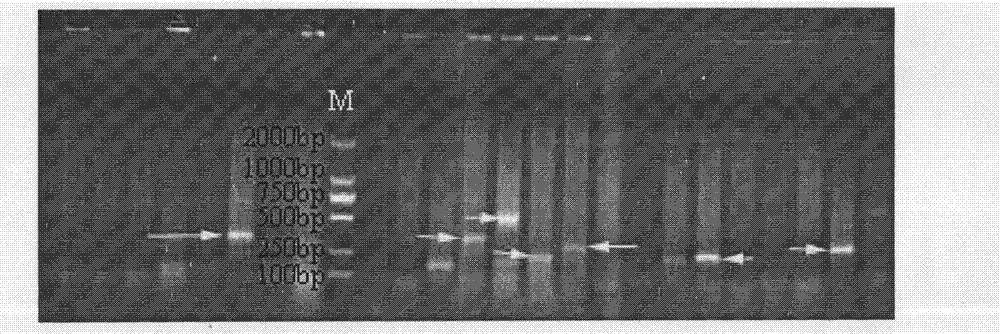Methods for acquiring micro-satellite sequence and polymorphic micro-satellite markers of hucho taimen and polymorphic micro-satellite markers of hucho taimen
A technology of microsatellite sequence and acquisition method, which is applied in the acquisition of jelly salmon microsatellite sequence and polymorphic microsatellite markers and the field of jelly salmon polymorphic microsatellite markers, can solve the problem of time-consuming and labor-intensive development of microsatellite markers. The risk and cost of microsatellite sequence separation, to achieve the effect of low cost and high safety
- Summary
- Abstract
- Description
- Claims
- Application Information
AI Technical Summary
Problems solved by technology
Method used
Image
Examples
specific Embodiment approach 1
[0020] Specific embodiment 1: In this embodiment, the microsatellite sequence of salmon salmon is obtained according to the following steps: 1. Extraction of salmon genome DNA; 2. Enzyme digestion of salmon genome DNA and construction of microsatellite enrichment library; 3. Bacteria colony PCR amplification and positive clone detection and sequencing, that is, to obtain the microsatellite sequence of jellyfish salmon.
specific Embodiment approach 2
[0021] Specific embodiment 2: The difference between this embodiment and specific embodiment 1 is that in step 2, restriction endonucleases are used to single-enzyme or double-enzyme digest the salmon genome DNA. Other steps and parameters are the same as those in Embodiment 1.
specific Embodiment approach 3
[0022] Specific implementation mode three: the difference between this implementation mode and specific implementation mode two is: the steps are divided into the following steps to realize:
[0023] a. Enzyme digestion of salmon genome DNA:
[0024]The jelly salmon genomic DNA digestion system is 20 μL, which consists of 2 μL 10× digestion buffer, 0.2 μL BSA with a concentration of 10 ng / μL, 2.5 U restriction endonucleases, 5 μL jelly salmon genomic DNA with a concentration of 100 ng / μL and The remaining amount is composed of sterilized deionized water; the enzyme digestion incubation time is 4h;
[0025] b. Connection:
[0026] The ligation system was 40 μL, which consisted of 20 μL of enzyme-digested fragments in step a, 2 μL of sticky-end double-stranded adapters, 4 μL of 10×buffer, 6 Weiss units of T4 DNA ligase and the rest of sterilized deionized water, and ligated overnight in a water bath at 4°C; The double-stranded linker was prepared according to the following ste...
PUM
 Login to View More
Login to View More Abstract
Description
Claims
Application Information
 Login to View More
Login to View More - R&D
- Intellectual Property
- Life Sciences
- Materials
- Tech Scout
- Unparalleled Data Quality
- Higher Quality Content
- 60% Fewer Hallucinations
Browse by: Latest US Patents, China's latest patents, Technical Efficacy Thesaurus, Application Domain, Technology Topic, Popular Technical Reports.
© 2025 PatSnap. All rights reserved.Legal|Privacy policy|Modern Slavery Act Transparency Statement|Sitemap|About US| Contact US: help@patsnap.com



